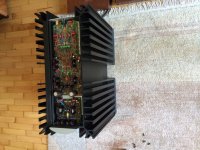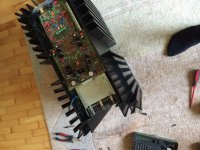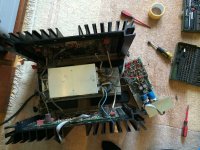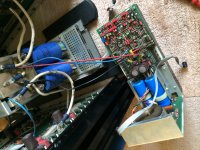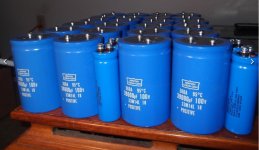I just finished reviewing two Plinius MA 102 dating from 91 or 92, the power capacitors were all perfect.
I think the ML33 is not very far in its design.
I will be you, I will not touch it.
I think the ML33 is not very far in its design.
I will be you, I will not touch it.
Ur not the first one to say this.
I have revamped many amps , preamps it's always a jump in quality
I get the comment but I can't leave them and not make them new in spect again.
I have revamped many amps , preamps it's always a jump in quality
I get the comment but I can't leave them and not make them new in spect again.
ALRAINBOW
Mouser is my archenemy the reason they received all my custom part numbers from Cornell Dubilier I had CDE Engineers make make all these parts about 10 years ago.
3186GJ503M125DPA2.
DCMC503M125DF2B/DCMC503M125DP2D/DCMC513M125DP2D
DCMC513M160DP2D. etc for ML-332/333/334/335/336.
They are charging 125 percent more than what they paid. $570 FOR 4 CAPS DCMC LINE.
Now for your Mark Levinson No.33 I recommend just replace 24 PSU caps and regulator caps the reason the amp works fine now. It is similar to ML-33H. Here is the Picture of 33H that was very dull In sound. My customer in Europe.replaced the 8 power supply caps the original Red China made Philips with Nichicon caps amde in Japan and super high end worlds best Cornell Dubilier.
If people want caps I can get caps for all Levinson and Krell much lower than Mouser/digikey here In my home state of Minnesota/Newark or Arrow etc.
Mouser is my archenemy the reason they received all my custom part numbers from Cornell Dubilier I had CDE Engineers make make all these parts about 10 years ago.
3186GJ503M125DPA2.
DCMC503M125DF2B/DCMC503M125DP2D/DCMC513M125DP2D
DCMC513M160DP2D. etc for ML-332/333/334/335/336.
They are charging 125 percent more than what they paid. $570 FOR 4 CAPS DCMC LINE.
Now for your Mark Levinson No.33 I recommend just replace 24 PSU caps and regulator caps the reason the amp works fine now. It is similar to ML-33H. Here is the Picture of 33H that was very dull In sound. My customer in Europe.replaced the 8 power supply caps the original Red China made Philips with Nichicon caps amde in Japan and super high end worlds best Cornell Dubilier.
If people want caps I can get caps for all Levinson and Krell much lower than Mouser/digikey here In my home state of Minnesota/Newark or Arrow etc.
I plan to go through all of it once I do caps
Partly is no manual to know tork pressure.
I do see a few caps were changed
Same brand and model newer date codes
Both amps too.
I'll post pics as I do it.
Do you have evidence that the capacitors in the board are not functioning well? Your amplifier starts up, there are no hisses or hums and it produces music without audiable distortion. This indicates the amp is stable and functions well, therefore the capacitors are doing their job. There are 30 year old caps which work fine. Have a read at the link below, a guy tests a 30 year old vintage pioneer amp and I quote ""It delivered 273.3 watts into 8 ohms and 338.0 watts into 4 ohms. It's a stereo receiver, but it totally blew away Denon's state-of-the-art flagship model in terms of power delivery!"
What i fear is that by replacing the capacitors you are trying to address a non-existant problem and may actually make things worse. A new capacitor brand may have different ESL and ESR from the originals, this could lead to instability so please think it over carefully.
Another reason not to change the caps is that currently you have a unmodified vintage audio set whose value will only increase in time, its potential re-sale and price value will grossly decline the moment you modify it.
How can 30-year-old receivers sound better than new ones? - CNET
Ur not the first one to say this.
I have revamped many amps , preamps it's always a jump in quality
I get the comment but I can't leave them and not make them new in spect again.
Do you have any measurements to say that there was a objective difference in quality after your modifications? If the original capacitors are working well, then by replacing them you wont be "make them new in spect again". Of course you will "hear" a difference after spending hours replacing 100's of capacitors, its likely psychological and your brain telling you it sounds better than any measurable difference.
Amplifier porn
Long term Levinson fan... nice seeing that 33H opened up,
as complex as it really is, it is really 'pretty simple'
straight forward, noted exemplary engineering,
Madrigal circuit symmetry, easy to model
and plan the work ahead. KUDOS!
Thanks for sharing!
HERE IS ML-33H
Long term Levinson fan... nice seeing that 33H opened up,
as complex as it really is, it is really 'pretty simple'
straight forward, noted exemplary engineering,
Madrigal circuit symmetry, easy to model
and plan the work ahead. KUDOS!
Thanks for sharing!
A new capacitor brand may have different ESL and ESR from the originals, this could lead to instability so please think it over carefully.
Thanks for making me laugh.
Another reason not to change the caps is that currently you have a unmodified vintage audio set whose value will only increase in time, its potential re-sale and price value will grossly decline the moment you modify it.
This increasing value theory does not work so well in practice. These old amps have been steadily declining in value until it has become pretty much constant. The Pioneer fan boys live in their own universe.
At the time i bought a pair of Jeff Rowland monoblocks half the big caps were leaking and it was only a question of time before corrosion ate up the chassis. I guess the previous owner was trying to preserve the collector's value by keeping it stock😛
The only time i have done a major revamp was on a perfectly functioning Krell. Every single cap was replaced with either an original or with a cap whose sonic signature i know and enjoy. Sadly, it was too hard to fit my favourite Mlytics as the main filters, so bought some really nice Siemens/Epcos. Took the opportunity to also reseat all the power transistors on Keratherm as the original pads were looking completely dried out. This reduced device operating temperature by nearly 5 degrees.
And of course changed the pathetic original termination to WBT. The final audible result was more than worth it.
The only time i have done a major revamp was on a perfectly functioning Krell. Every single cap was replaced with either an original or with a cap whose sonic signature i know and enjoy.
The final audible result was more than worth it.
Could you show us the measurements after your mod which shows significant improvements in THD, IMD etc when compared to the original. Our Ears are very unreliable and of course you would psychologically perceive a improvement after spending hours modifying a perfectly functioning audio gear. Without measurements to support, your claims that capacitor mods improved on what the krell audio engineers originally acheived are meaningless.
Last edited:
Took the opportunity to also reseat all the power transistors on Keratherm as the original pads were looking completely dried out. This reduced device operating temperature by nearly 5 degrees.
.
I hope you also adjusted the new idle bias current to compensate for the reduced new output transistor operating idle temperature. Without doing this the amplifiers distortion could change for the worse by your mod.
We should be humble to realise that amplifiers are designed by professionals who have spent their lives studying this stuff with complex instrumentation to test what they create and not by people tinkering in their mothers basement. Modifying a professional amplifier should be done very carefully and without scientific measurements done before and afterwards, no one can be confident to say that their mod made a significant improvement if any.
I hope you also adjusted the new idle bias current to compensate for the reduced new output transistor operating idle temperature.
In this particular amp idle current is automatically maintained at a fixed value and does not depend on temperature (KSA250). Besides what i have done is take the temperature conduction back to the original specs - the original pads had tuned themselves into crisps after 20 years of 70deg operation. Not sure if mica with heat conductive compound would have done better or worse, the point is that this type of maintenance is essential.
Could you show us the measurements after your mod which shows significant improvements in THD, IMD etc when compared to the original.
Why would anyone expect any reduction in distortion? This would be really naive. As for measurements, i always take those just to make sure nothing has gone wrong. It was perhaps the highest distortion solid state amp i have ever measured. Sounded none the worse for it.
this would be the perfect time to start a debate:
% distortion vs listening pleasure.
to return to this debate: Mica vs pad.
As soon as I can, I also replace mica with Keratherm pad.
% distortion vs listening pleasure.
to return to this debate: Mica vs pad.
As soon as I can, I also replace mica with Keratherm pad.
Why would anyone expect any reduction in distortion? This would be really naive. As for measurements, i always take those just to make sure nothing has gone wrong.
I take it that your whole purpose of replacing capacitors is to improve on the existing performance of the amplifier. Since you proudly claim "The final audible result was more than worth it.", it is logical to assume that there should have been a measurable improvement in parameters like THD, IMD, noise etc if your golden ears were telling the truth. Would you care to post the measurements before and after your mod which accounted for such a dramatic improvement in sound quality which your ears heard?
It was perhaps the highest distortion solid state amp i have ever measured. Sounded none the worse for it.
I find it strange that despite your claims that the KSA250 was "the highest distortion solid state amp i have ever measured", in reality it showed a very respectable (for a 90s design) THD+Noise at moderate to high output powers: typically 0.1% through most of the band, rising to 0.2% at 20kHz (Stereophille).
Krell KSA-250 power amplifier Measurements | Stereophile.com
- Status
- Not open for further replies.
- Home
- Amplifiers
- Solid State
- Mark Levinson No. 33
